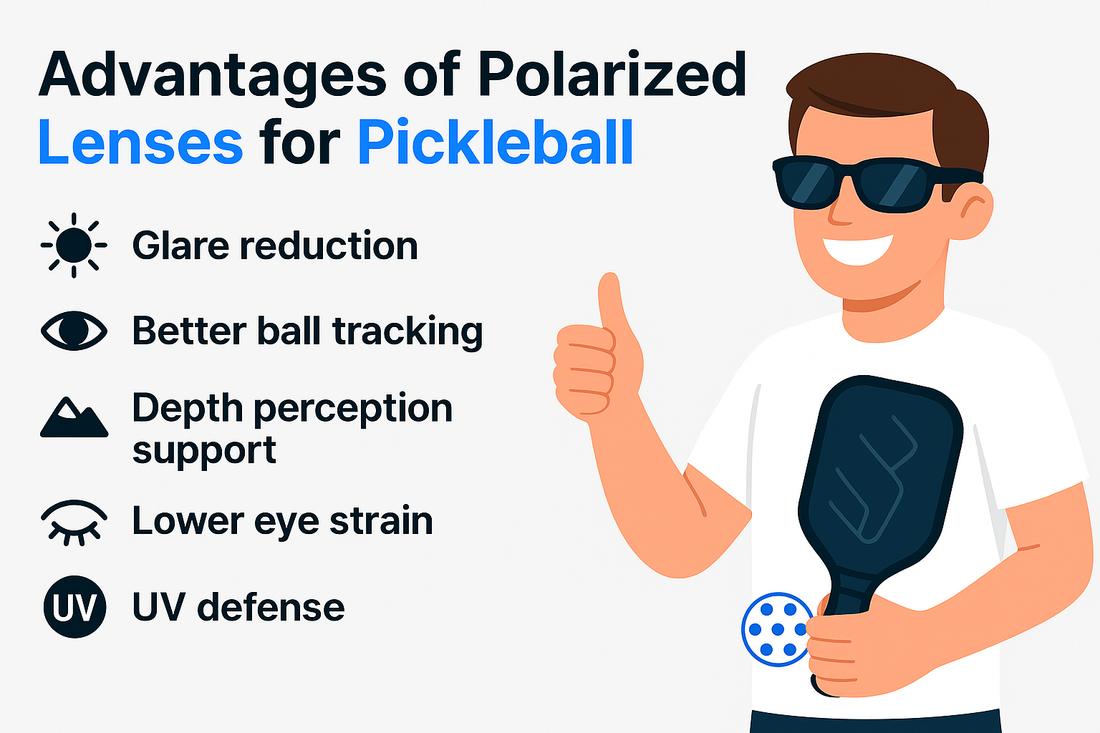
Advantages of Polarized Lenses for Pickleball
Sun-baked courts, bright lines, and a fast-moving ball can turn a fun match into a squint-fest. If you play under clear skies, polarized lenses can be a quiet competitive edge that keeps your eyes relaxed and your reactions sharp. Here is how they help you see more and stress less on every rally. ☀️
What polarizing actually does
Polarized lenses contain a microscopic filter that blocks horizontally reflected light, which is the harsh glare bouncing off painted lines, glossy paddles, and even light-colored courts. By cutting this reflected glare, these lenses improve clarity, boost contrast, and sharpen edges without simply making everything darker. The result is a more comfortable view that helps you pick up the ball sooner and track its spin more confidently. 👀
Why this matters on the pickleball court
- Glare reduction: Fewer blinding flashes from the court surface or nearby glass means steadier focus during serves and volleys.
- Better ball tracking: Increased contrast helps you read trajectory and spin, especially against pale or sunlit backgrounds.
- Depth perception support: Reduced visual noise makes distance judgment feel more natural, which can tighten your footwork near the kitchen line.
- Lower eye strain: Less squinting equals less fatigue over long matches and tournaments.
- UV defense: Quality lenses also block UVA and UVB rays to protect eye health while you rack up court time.
- Consistent vision: From early morning dew to high noon brightness, polarized optics deliver stable, comfortable visibility. 🎾
Best tints and coatings for outdoor play
Lens color influences how you perceive contrast and brightness. A few reliable choices for pickleball:
- Brown or amber: Great all-around choice that boosts contrast on green or blue courts without distorting color too much.
- Gray: Neutral and natural-looking in intense sun, ideal if you prefer true-to-life colors.
- Rose or copper: Excellent in variable light or light overcast, enhancing depth and ball definition.
- Mirror coatings: Help reflect additional light to keep things cool and reduce surface reflections for extra comfort.
- Photochromic options: Transition from lighter to darker automatically, helpful if you play across changing conditions.
Frame features that make a difference
Polarization is only one piece of the puzzle. The right frame keeps your optics in the optimal position and stays put when rallies heat up:
- Wraparound coverage: Wider fields of view with fewer gaps prevent stray light from sneaking in at the sides.
- Grippy contact points: Rubberized nose pads and temple tips keep glasses stable through quick cuts and overheads.
- Vented designs: Small airflow channels reduce fogging during humid matches.
- Lightweight materials: Less bounce, better comfort, and fewer distractions.
- Prescription-ready frames: If you need Rx, choose sport frames designed to handle your prescription without adding distortion.
Common misconceptions and quick tips
- Not just sunglasses: Polarized lenses are about clarity, not only tint. You can have polarization with performance tints that enhance contrast.
- Indoor play: Many indoor courts do not need polarization. For bright indoor lighting, consider clear or lightly tinted lenses with anti-reflective coating instead.
- Digital displays: Some polarized lenses can make certain LCD scoreboards look dim at specific angles. Tilt your head slightly or test your lenses before a tournament.
- Care habits: Rinse dust with water before wiping, use a microfiber cloth, and store in a hard case to prevent scratches.
How to pick your pair
Match your lenses to your most common conditions, then dial in fit. If your courts are bright and open, gray or brown polarized lenses with a mirror finish offer versatile protection. If you play morning to late afternoon, photochromic polarized options adapt smoothly and help you avoid swapping eyewear mid-day. Finally, try on a wraparound frame that seals out side glare and sits securely when you lunge, pivot, and sprint. Your eyes relax, your reactions feel crisp, and your game benefits at every point. 💪
FAQs
How do polarized lenses help in pickleball?
They cut harsh glare from court surfaces and equipment, improving clarity and comfort so you can track the ball sooner and with less eye strain.
What lens color is best for outdoor pickleball?
Brown or gray are versatile choices. Brown boosts contrast on common court colors, while gray keeps colors natural in strong sun.
Can I use polarized lenses for indoor courts?
Usually you do not need them indoors. Clear or lightly tinted lenses with anti-reflective coatings work better under artificial lighting.
Do polarized lenses make scoreboards harder to see?
Sometimes LCD screens can appear dim at certain angles. A slight head tilt or testing before a match typically solves it.
Why choose polarized over non-polarized sunglasses?
Polarized lenses reduce reflected glare, which means sharper vision, less squinting, and steadier depth perception in bright outdoor play.



